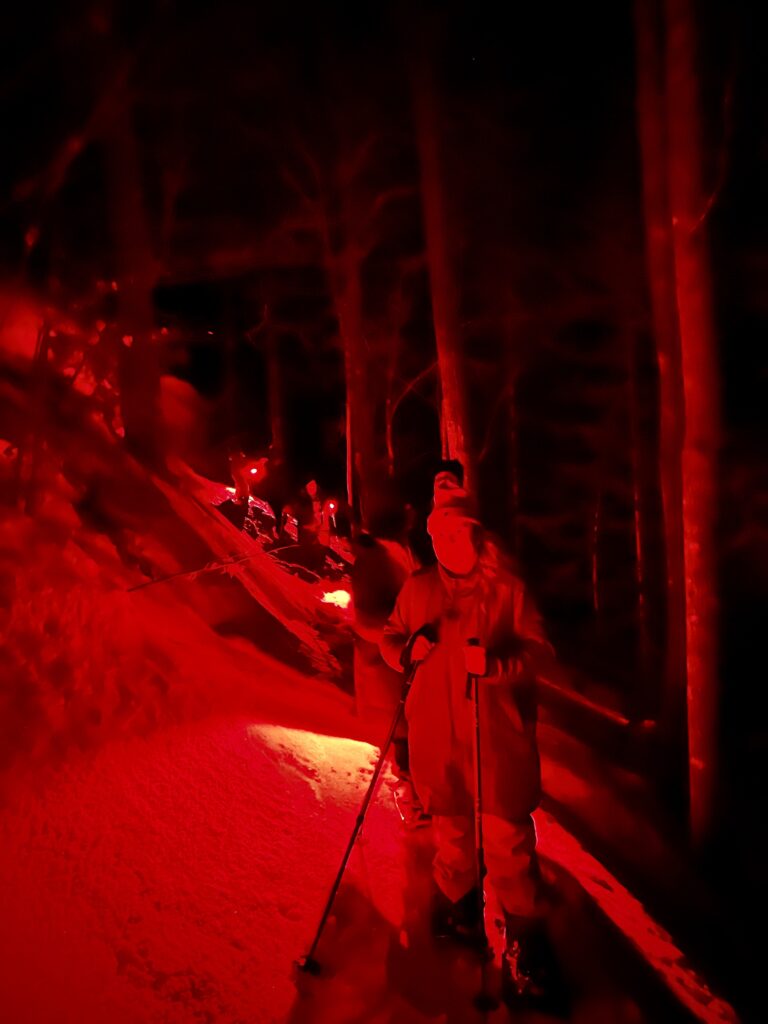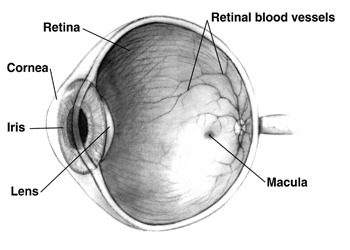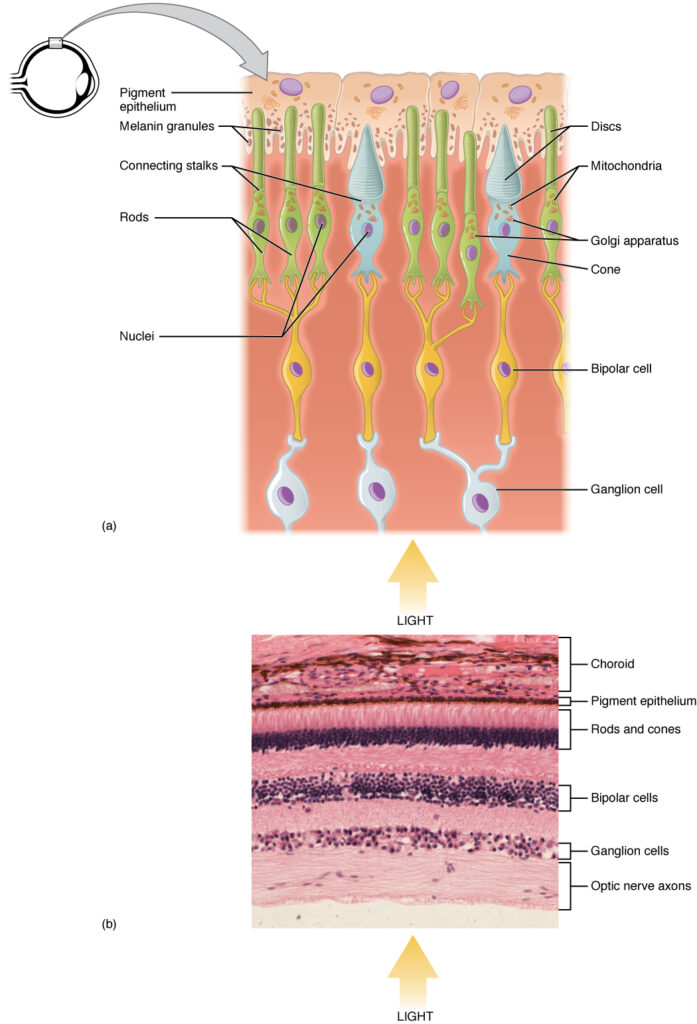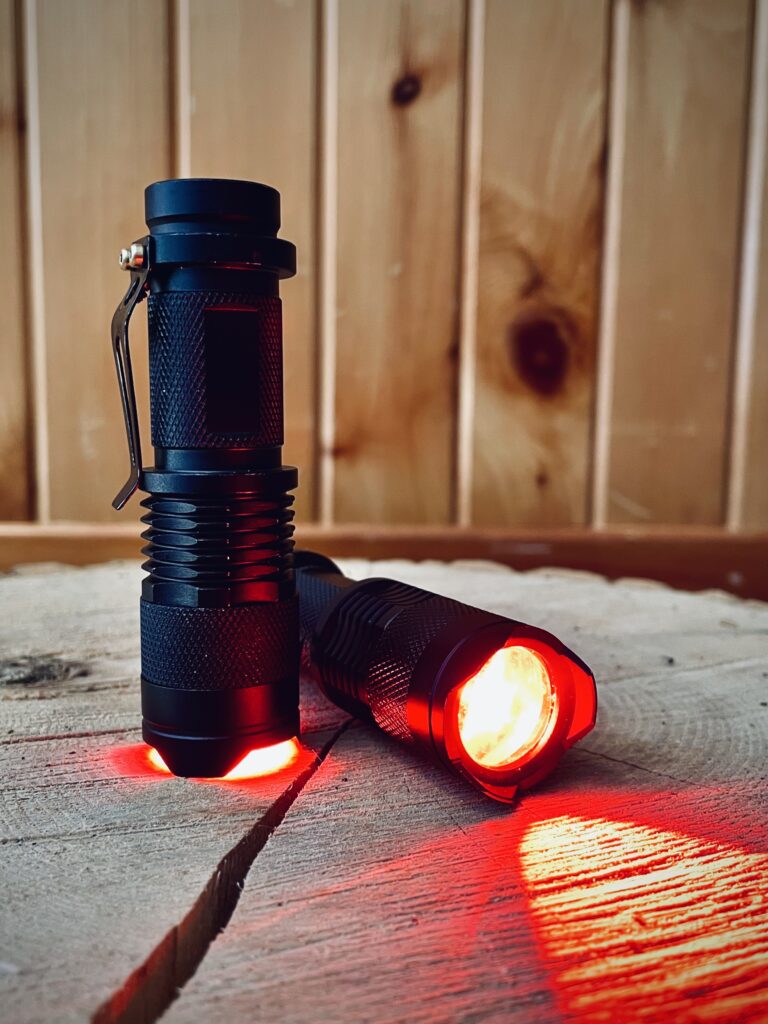Top of the Keweenaw Tidbits: Why red light is better for night-time activities
A question we repeatedly answer when venturing out for night-time activities (e.g., Night Photography Workshops and Moonlit Snowshoe Hikes) is “Why do you recommend flashlights or headlamps that emit red-colored light?”

The basic answer to that question is that red-light does not ruin people’s night vision as much as other colors of light, especially white light. So, to maximize a person’s nighttime outdoor experience we suggest using a flashlight that emits red light.
For some people that is a suitable answer. However, I tend to be one of those people who, like a 3-year old, keeps asking “Why?” until I feel I have a good understanding of the science behind a phenomenon. So, to accommodate that persistent 3-year old in all of us, the remainder of this blogpost will delve into the science behind the reduced impact of red-colored light on human night vision.
Natural human exposure to light:
Here, at the “Top of the Keweenaw,” the amount of daylight (which, for simplicity, I will define as the time beginning with morning civil twilight and and ending with evening civil twilight) fluctuates between 9 hours 39 minutes (on the winter solstice) and 17 hours 18 minutes (on the summer solstice. If we sleep, on average, 8-hours per day, that means (prior to the invention of artificial light) humans, living at the same latitude as the region we now call the Keweenaw, needed to be able to see in darkness for up to about 6 hours 20 minutes (for humans living in higher latitudes there were longer periods of darkness).
Human eye anatomy:
As a flashback to high school biology, the human eye’s form is to serve the function of focusing light on the innermost tissue of the eye (retina), which contains light-sensitive cells. To trigger these light sensitive cells, light must pass through a lens suspended within an opening (pupil), which is capable of changing in diameter depending on the brightness of the environment. When the environment has an increased availability of light, the pupil is narrowed. In low light conditions, the pupil is widened to allow as much light into the eye as possible.
The most common thing that people think of regarding our ability to see at night is that the pupil widens to allow more light in and then constricts when the eye is exposed to bright light. Then, when the light levels decrease again, the pupil widens in response. This response in the pupil is actually relatively quick, so many people think that bright white light has a minimal effect on night vision. However, our ability to see in darkened conditions is a bit more complex.

Retina composition (rods vs. cones):
Since humans tend to live a diurnal (daytime) life, we need to be able to see in both light and dark environments. For this to occur, our eyes have two types of light sensitive cells:
- Cones, which are primarily used for detailed color vision, and
- Rods, which function in low-light levels and provide less detailed gray-scale vision.
Early humans needed threat detection at night; so, while rods function poorly for sensing detail, they work best at detecting motion. Since threats tend to sneak up from the side or behind, rods are most concentrated within the retina along its periphery, whereas cones are most concentrated near the central part of our vision. Ultimately, this arrangement of retinal cells allows humans to more effectively detect motion at the edge of their view at night, while being able to see detailed colored objects straight ahead during times when there is more available light. If you have ever noticed that as dusk progresses, it is easier to locate faint stars by not looking straight at them, this is a technique which uses peripheral vision called “averted vision.”

Rhodopsin:
The way that light sensitive cells work is that they have, like other nerve cells in the body, chemical transmitters which are triggered by a stimulus (light). For rods, that chemical is a pigment protein called rhodopsin (cone cells have different pigment proteins that carry out a similar function). Basically, as light levels drop, rhodopsin begins to become active in the rods and night vision is able to set in.
Photoreactivity of rhodopsin:
As mentioned earlier, people often think that the most important factor for improved night vision is how large the pupil opening becomes as a response to low light. While that physical response is important, pupil diameter actually maximizes very quickly (within a few minutes) to dark exposure; where as night vision can take a very long time to maximize. The more important factor in night vision is the pigment rhodopsin. The way that rhodopsin works is that photons of light strike the pigment, causing it to change shape. That shape-change in the protein then triggers a sequence of reactions, ultimately resulting in an electrical signal which travels along the optic nerve, which is interpreted by the brain. Rhodopsin is so sensitive to light that it can react to a single photon of light (which makes rod cells about 100 times more sensitive to light than cone cells). Once rhodopsin is activated by light, it takes between 20 and 40 minutes for it to return to its original shape, which will then allow it to react to light again. Therefore, even a short burst of bright light (which contains a high concentration of photons) will cause rods to stop working and they will not return to their full capability until the rhodopsin can return to its reactive shape.
It has been discovered that rhodopsin is not triggered by deep red-colored light. However, It is rare to find light that contains a pure single color. Since red-colored light we see often has some blue-light and green-light, it can trigger the rhodopsin in the rod cells. This means that a very bright red-colored light is capable of triggering some of the rhodopsin in rod in red cells and consequently limiting night vision. That being said, a dim red-colored light still remains better for maximizing after-dark vision when compared to lights of other color.
Bring a Red Flashlight to After Dark Events
Here at the Keweenaw Mountain Lodge, we strongly encourage people participating in after dark events to use flashlights or headlamps which emit red-colored lights. (Please note: While these lights are red-colored, we have specifically selected “red” flashlights that are brighter than most red LED lights. We decided to provide these brighter red LEDs so guests could benefit from improved night vision while still having a bright enough light to better navigate uneven, forested terrain.)
For the reasons mentioned above, flashlights, headlamps, and cell phone lights which emit white light are discouraged. To aid in that request, the Outdoor Activity Center has flashlights which emit red-colored light available for guests to borrow.

If you do not have access to flashlight or headlamp which emits red-colored light, it is also possible to convert a standard flashlight to red by:
- using red cellophane with a rubber band (or a red-colored zip-top resealable bag) to cover the lens of the flashlight.
- “paint” the plastic lens of an older flashlight with red nail polish or a red magic marker.
Flashlight Etiquette:
Have you ever been in a dark room for a long enough period of time that your eyes have become accustomed to the low light and then someone unexpectedly turns on the lights? It can be so bright at that initial moment it can feel painful. Please consider that reaction to bright light when participating in after dark events with the Keweenaw Mountain Lodge. Sudden bright lights can impact the experience of, not just yourself but, others around you.
Be thoughtful in the sources of light you are producing and follow these suggestions to minimize your light impacts.
- Use a light that emits red-colored light.
- Never shine a flashlight/headlamp/cell phone light (including a “red” flashlight) in the direction of another person.
- If you are wearing a headlamp, remember that if you turn your head toward someone else, you are shining your light directly at them.
- If possible, shield your cell phone screen, camera LCD, or other similar screens from others when outside in the dark.
- When using your light (even if it is red) around others try to reduce the amount of light being broadcast by covering the lens with your hand and only allowing the amount of light you need to pass through gaps between your fingers.
- Use a small amount of dark non-residue tape (e.g., gaffer tape or black painter tape) to cover the recording light on your camera).
- Recognize that others might not realize the impact they are having on your experience. When others are using lights, be tolerant if they accidentally disturb you with their light and remain polite if it happens repeatedly.

Since I was a child, nature, wildlife, and the outdoors have always been my deepest fascination – the intrinsic force which drives me. Those interests led me through, both, my career (in wildlife ecology/management and science education) and my preferred forms of recreation (hiking, backpacking, canoeing and kayaking, photography, hunting and fishing, and birding). Although, I was born and raised in the UP, these pursuits also provided me the opportunity to live overseas (in Europe and Asia) for 15 years, which greatly expanded my experience with the outdoors and outdoor recreation in different cultures. So, if you’re interested in anything related to the outdoors, stop by the Lodge (or catch me anywhere you may see me on the grounds) to chat about or get set up for your next outdoor adventure.